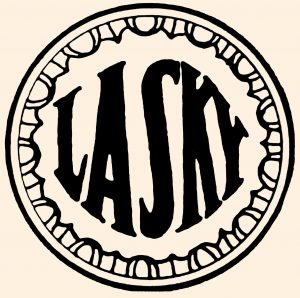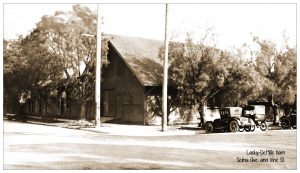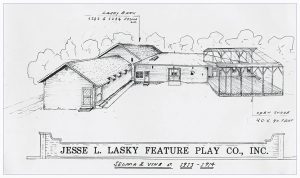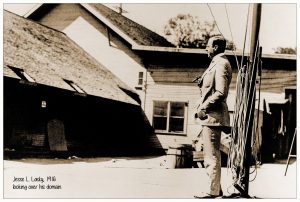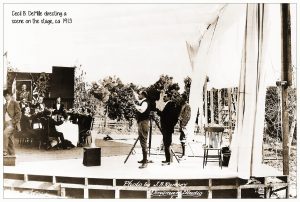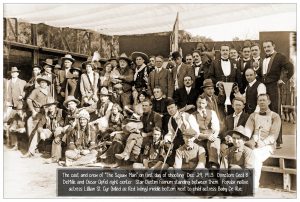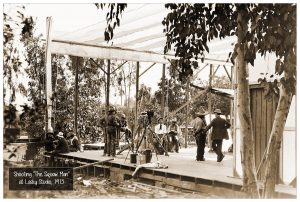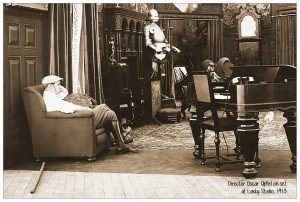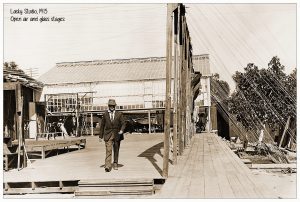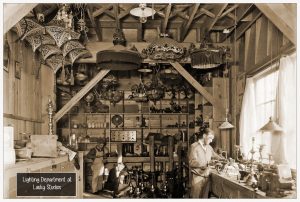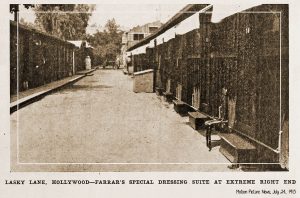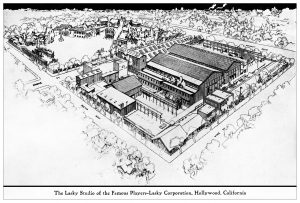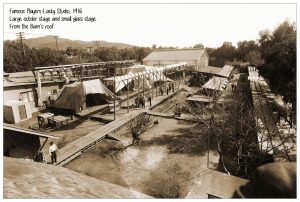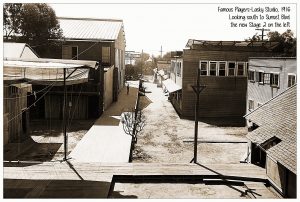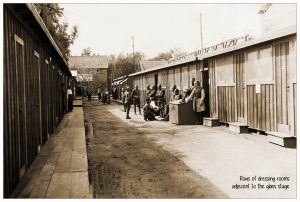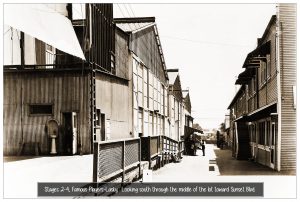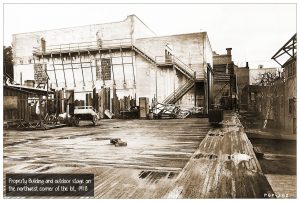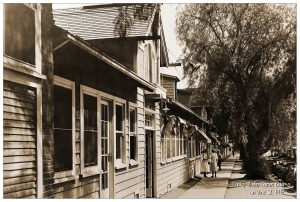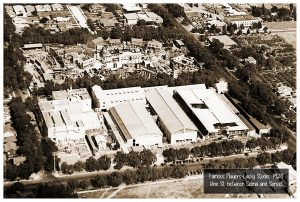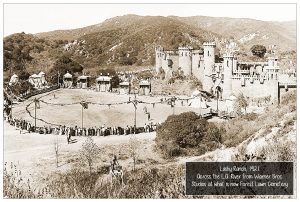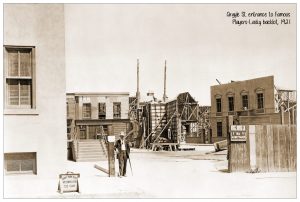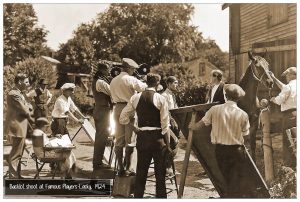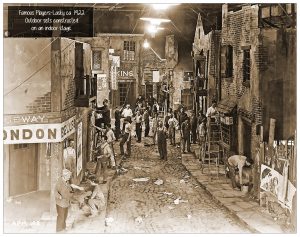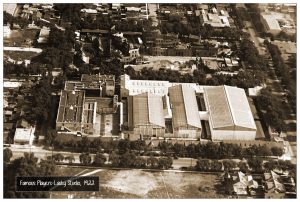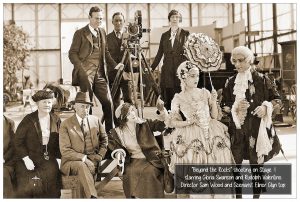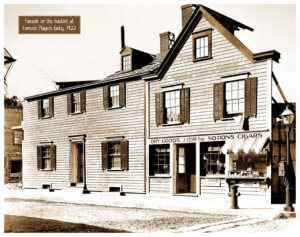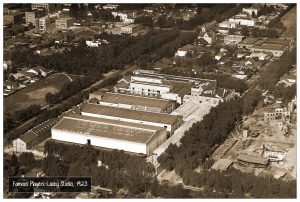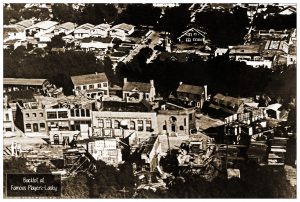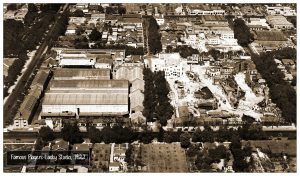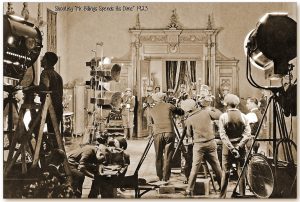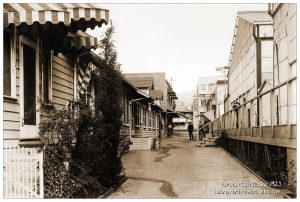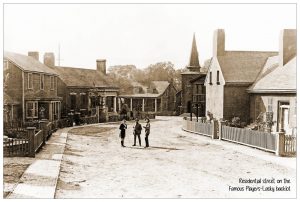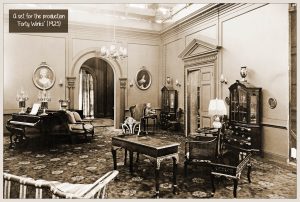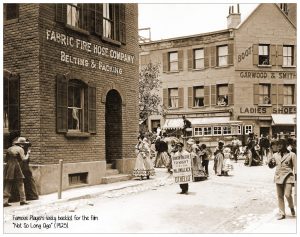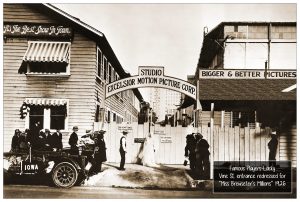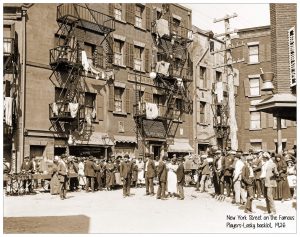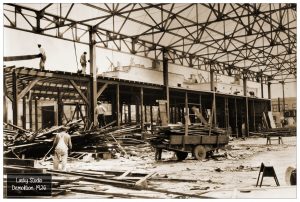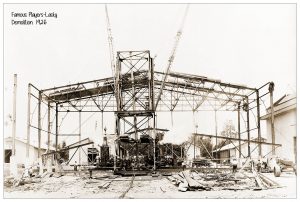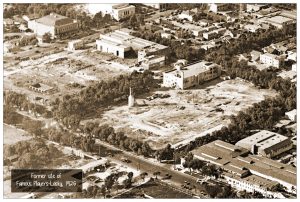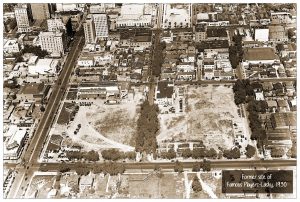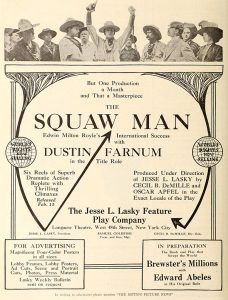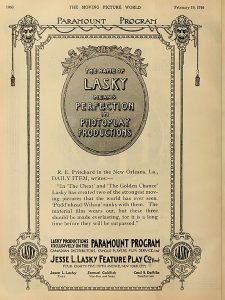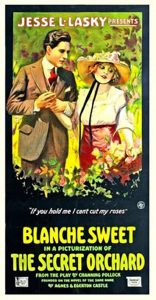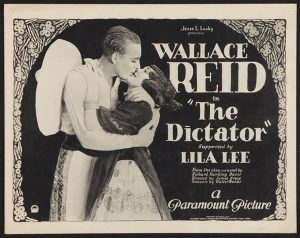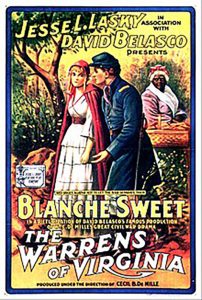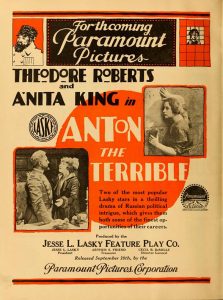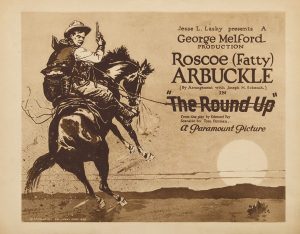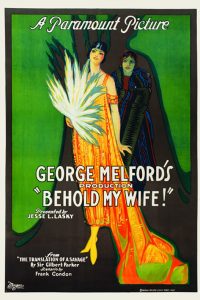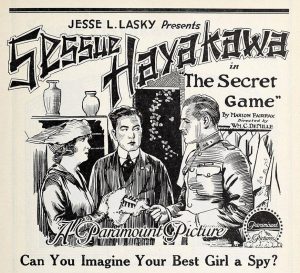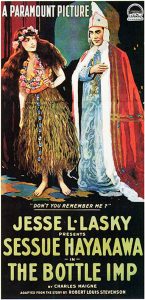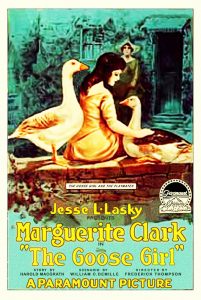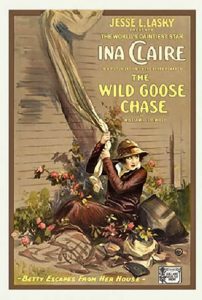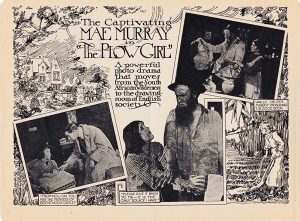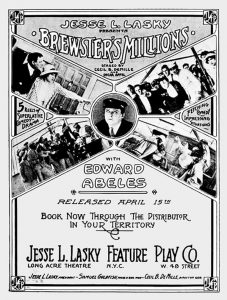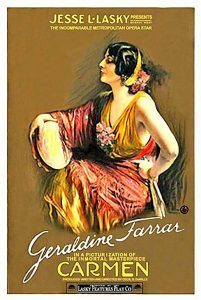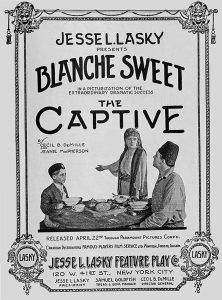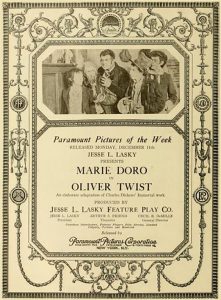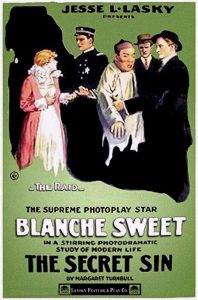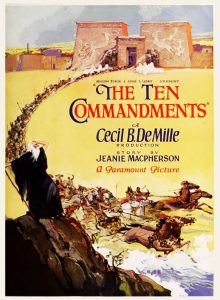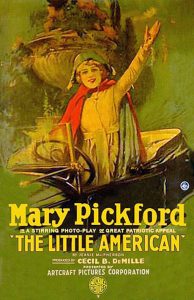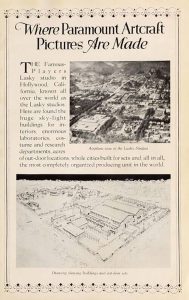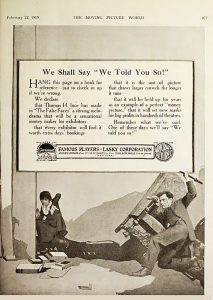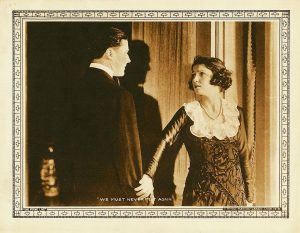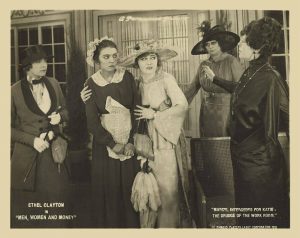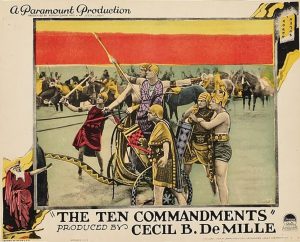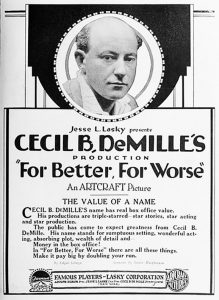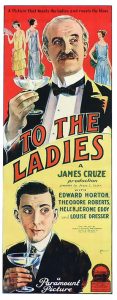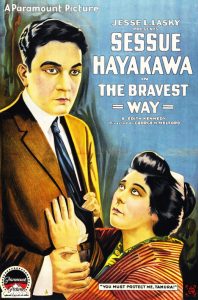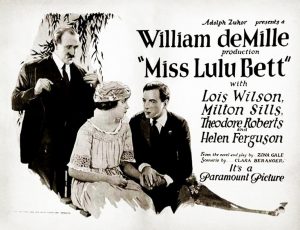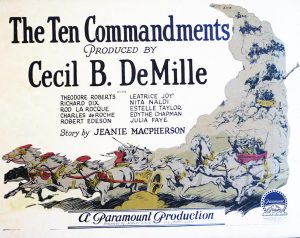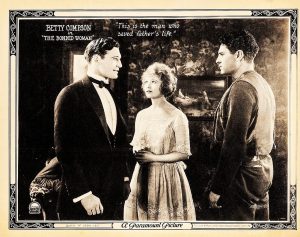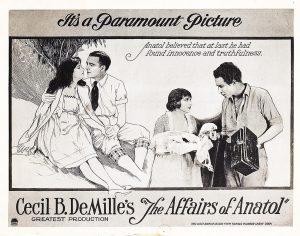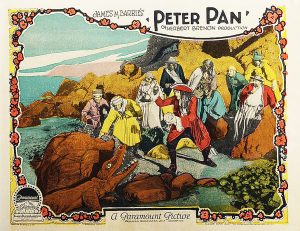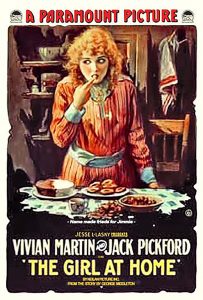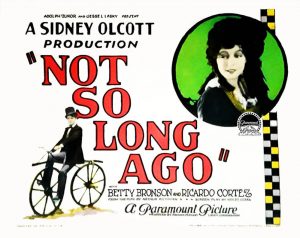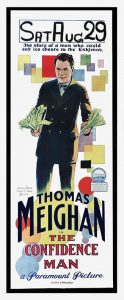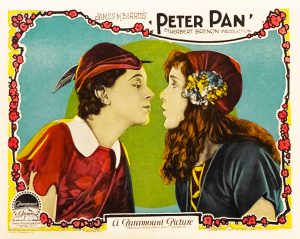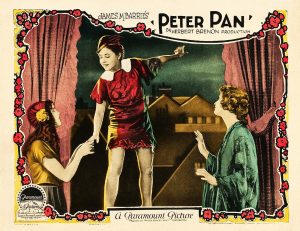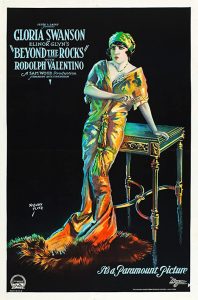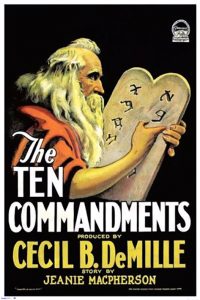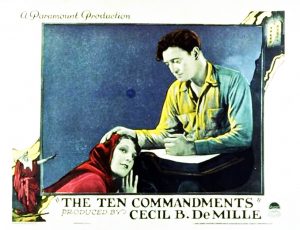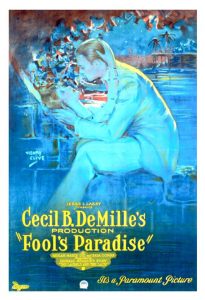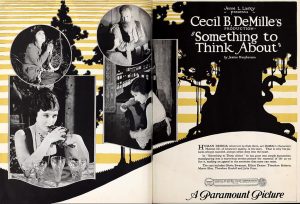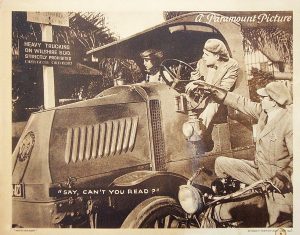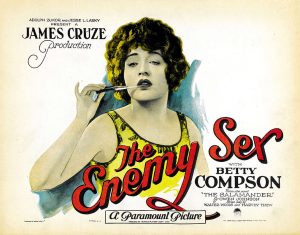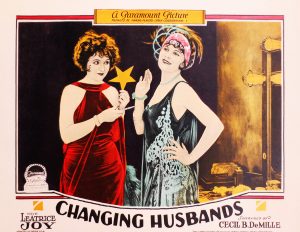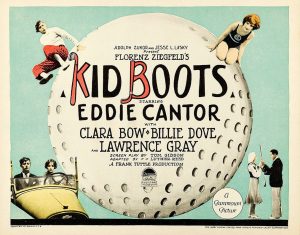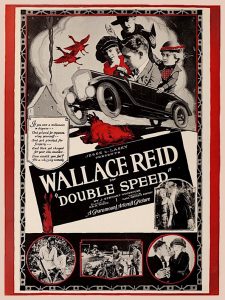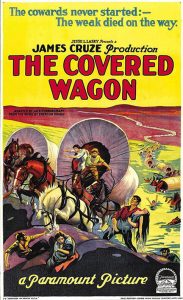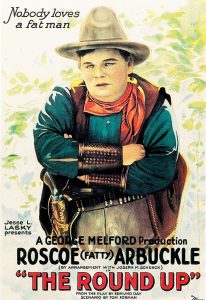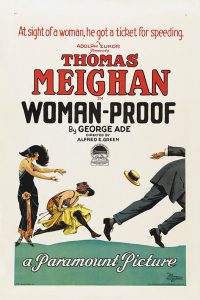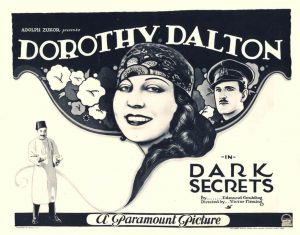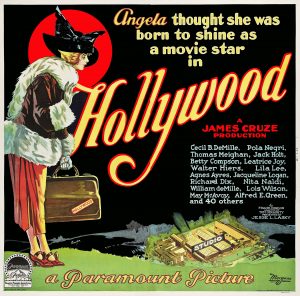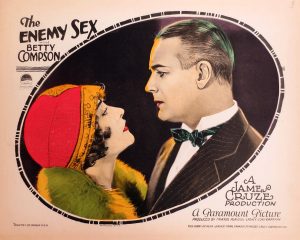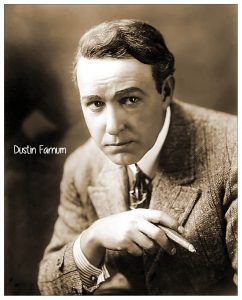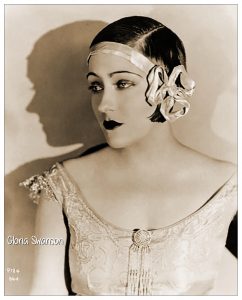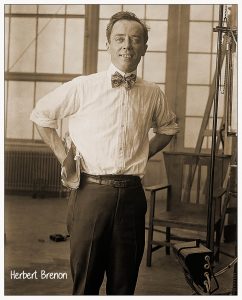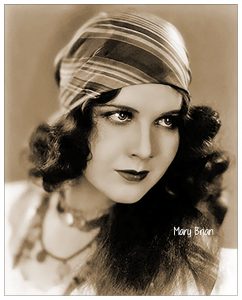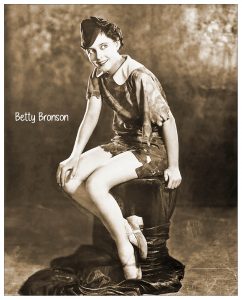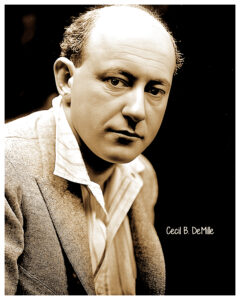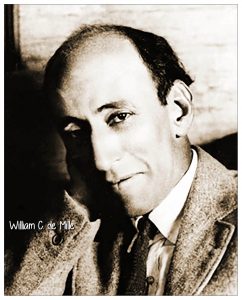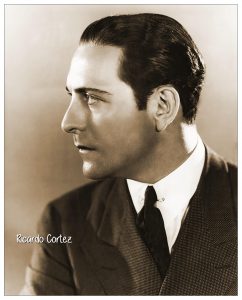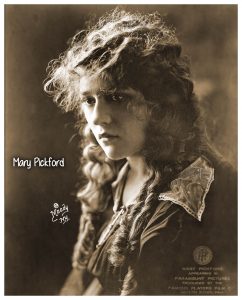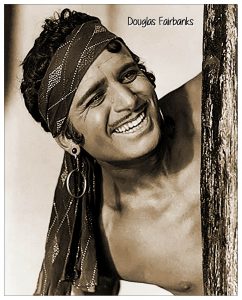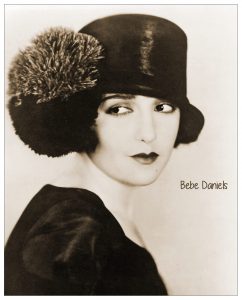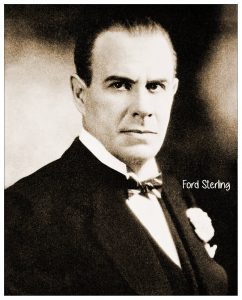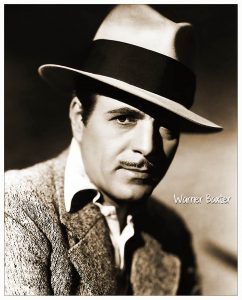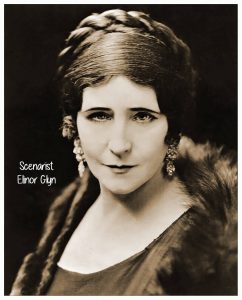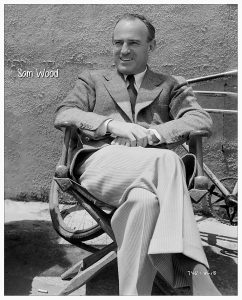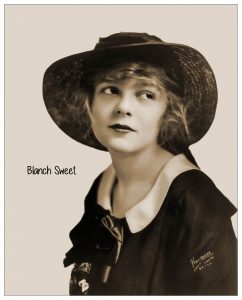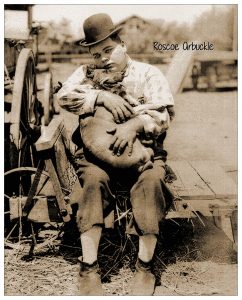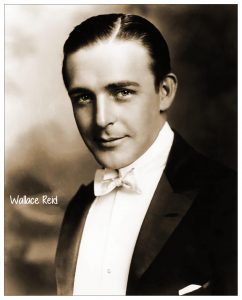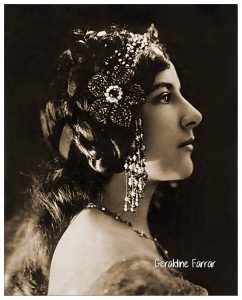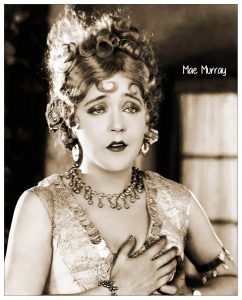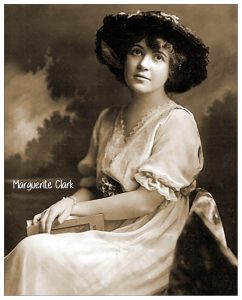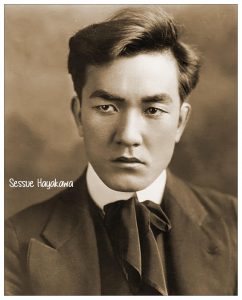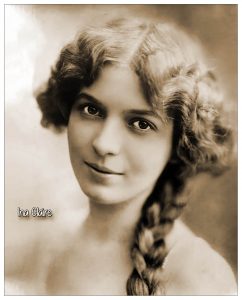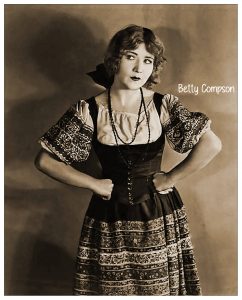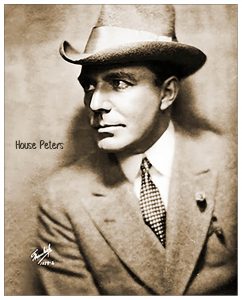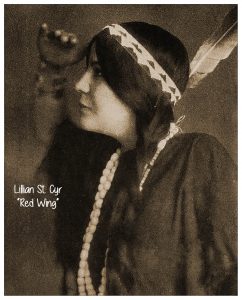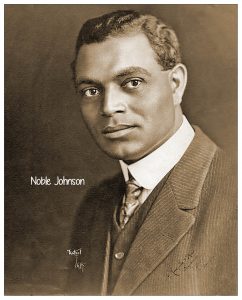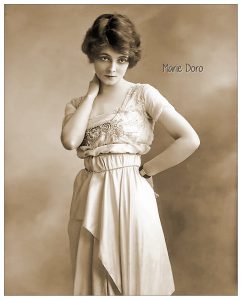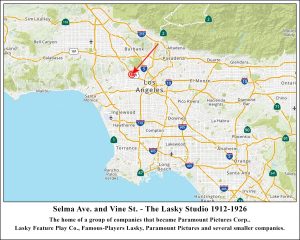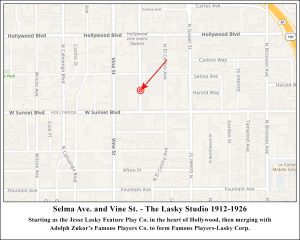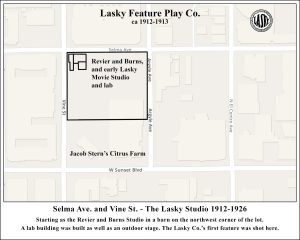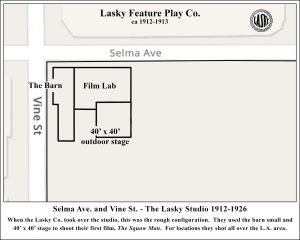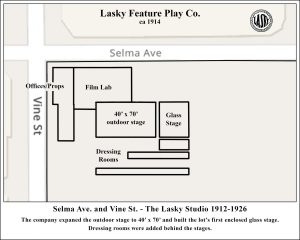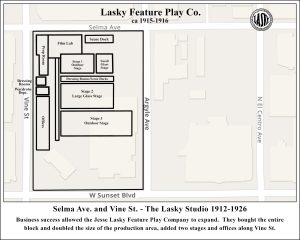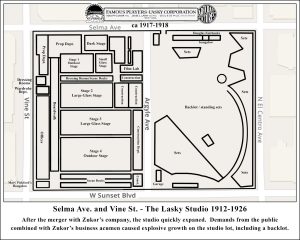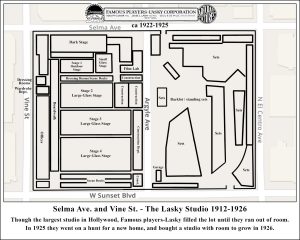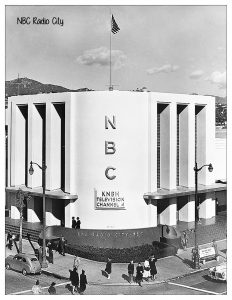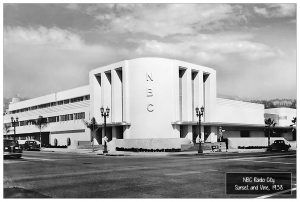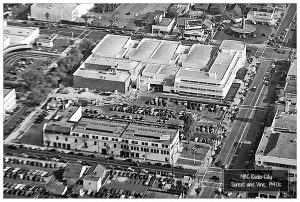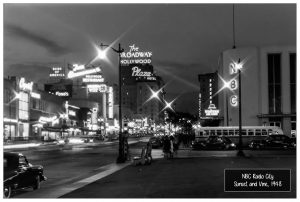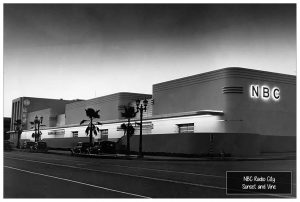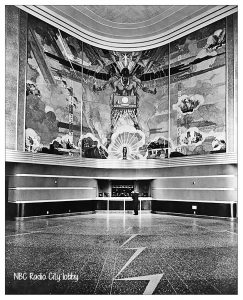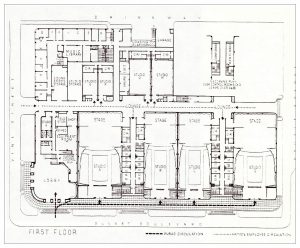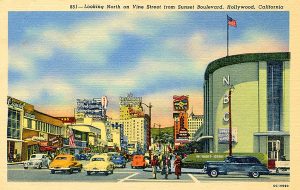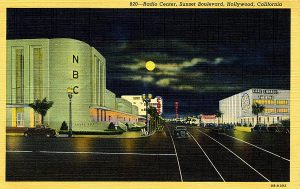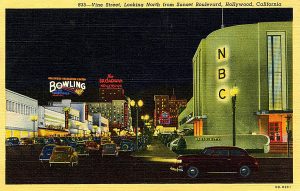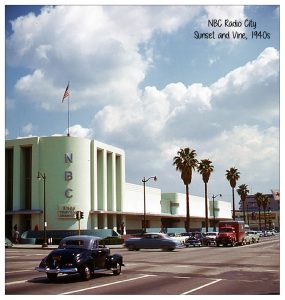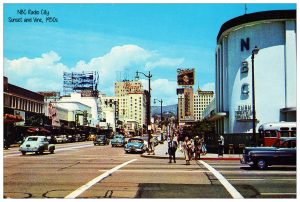The Corner of Selma and Vine in Hollywood
A tale of three powerful companies that became one
Lasky Company, Famous Players Co., and Paramount Pictures
Hollywood's first large, modern, full-service studio, the studio where Hollywood's first feature
length film was shot, and the studio that became the model for all the big studios that followed.
The Squaw Man
History was made here. The site was a barn at the corner of Selma and Vine in Hollywood. Actually half a barn...the other half had stalls for the animals. Cecil B. DeMille, the Director-General of the Jessie Lasky Feature Film Co., used a makeshift stage on the backside of the barn, put up some cloth over it to diffuse the sun, built some sets, and set up the camera and began to shoot.
The script was from the play of the same name by playwright Edwin Milton Royle. Part of the agreement with Royle was that they shoot action scenes on the actual sites mentioned in his book, which Lasky and DeMille gladly did, using the market slogan "The World Is Our Studio."
It would be DeMille's directorial debut. The movie was co-directed by veteran Oscar Apfel, giving DeMille the steady and watchful grounding as he learned the craft. Along with years of stage directing experience, Apfel had directed nearly 50 movies. The Squaw Man starred popular stage actor, Dustin Farnum, Farnum's wife Winifred Kingston, and noted American Indian actress Lillian St. Cyr who used the stage name, Red Wing.
The total box office for the movie was over half a million dollars, quite a sum for the day, and enough to allow the Lasky Company to expand and keep making movies.
Other Movies
During the years 1913-1916, the company produced nearly 100 films, including Brewster's Millions, The Master Mind, The Only Son, The Virginian, Carmen, The Goose Girl, The Secret Sin, The Ghost Breaker, The Man on the Box, The Circus Man and Cameo Kirby. In 1916 Laksy merged with Adolph Zukor's Famous Players Film Co., yet produced nearly 75 more movies under the Lasky banner after the merger.

Lasky Feature Play Co.
Lasky Studio
6284 Selma Ave. at Vine St.
Active 1912-1916
In March of 1912 small time actor/director Harry Revier and future founder of Western Costume Co., L.L. Burns, leased a small barn that stood at the corner of Selma and Vine as a studio. The barn was later made famous as the Lasky-DeMille barn, where Hollywood's first feature length movie was shot. Revier and Burns used the barn for their short-lived production company, the Fox Motion Picture Company (not to be confused with William Fox Film Corporation). They built an outdoor stage measuring 40' x 40'. Adjacent they built a new structure for their film laboratory business.
It does not look like Revier and Burns actually made movies here. Instead they rented it out to a couple of movie producers, including the Fred Mace comedy unit of the Balboa Amusement Company while their own studio was being built in Long Beach.
Jesse Louis Lasky was born September 13, 1880 in San Francisco who, according to his autobiography, was a failed coronet player. He and his sister, Blanch, entered the entertainment business by producing a couple of Broadway plays. Knowing nothing about making movies, the Laskys, along with Blanch's husband, Samuel Goldfish (later known as Samuel Goldwyn), and theatrical manager Cecil B. DeMille, formed the Jesse L. Lasky Feature Play company in 1913. Goldfish and DeMille packed their bags and headed west. After a brief stop in Arizona and rejecting it as a place to make movies the moved on to the burgeoning Hollywood film colony. Success is what they were after. Success is what they found...together and separately. Lasky would later join them.
The Lasky Feature Play Company formally incorporated on November 23, 1913 and rented the studio from Revier and Burns December 22. It was initially just the northwest 2.5 acres of the Jacob Stern citrus farm that was bounded by Selma St. running north and Sunset Blvd. on the South, Vine St. on the west and Argyle Ave. on the east. It was just a short walk from Hollywood's first studio a block away.
click to enlarge
Related Pages:
Many of the industry's biggest names mad appearances at the Lasky studio. Stars and directors included: Herbert Brenon, Mary Brian, Betty Bronson, Dustin Farnum, William deMille, Mary Pickford, Rudolph Valentino, Ricardo Cortez, Mary Pickford, Douglas Fairbanks.
Lasky Studio Growth
The little studio measured approximately 365 feet along Selma Ave. and 335 feet down Vine St., just a fraction of the size it would eventually grow to. For now, Lasky was content to expand the outdoor stage to 40' x 70' and build a second stage.
On Feb. 21, 1914, The Lasky Feature Play Co. bought Burns and Revier's studio assets and bought out the lease with Jacob Stern, becoming Stern's tenant directly instead of subleasing.
When Lasky took over the studio, in addition to the barn, there was a small 40' x 40' outdoor stage and a film lab building. The next course of action would be to expand the stage to 70' x 40.' As a part of a lease renegotiation, Stern approved the construction of a glass-enclosed stage behind the outdoor stage on the first of July, 1914. Dressing rooms were built behind the stages and offices were built along Vine Street. The Barn became offices and the Prop Department. Sometime during this period, The Lasky Company bought the studio lot, which consisted of the northern 2/3 of the block.
November of 1915 the Lasky Company bought the remainder of the block (southern 1/3) from Jacob Stern Real Estate. Two more large enclosed stages were erected in the middle of the lot. Stage 2 circa 1915 and Stage 3, measuring 60 x 200 feet, which began as an outdoor stage, was enclosed circa 1916. In a complex transaction in March 1917 (after the merger with Zukor) it appears that Cecil B. DeMille bought the entire block and sold the original footprint (northern 2/3) to the Lasky Company (as separate property from that of the merged company), retaining the smaller section of the block as his separate property. (I am still researching this part of the history and will update as information becomes available).
The 4,000-acre former Universal-Nestor Movie Ranch was leased in October. David Horsley, who built Hollywood's first studio (just down the block), leased this property for outdoor shooting. When Horsley's Nestor Studio was merged into Universal Studios they inherited the former Providencia Ranch. Lasky leased the property soon after Universal gave up their lease, and named it Lasky Ranch. Today it is the site of Forest Lawn Cemetery.
This was a highly profitable period of the studio, and they began to fill out the block, setting up the company for its merger with Adolph Zukor's Famous Players Film Company.
And...at the same time, there were two other companies:
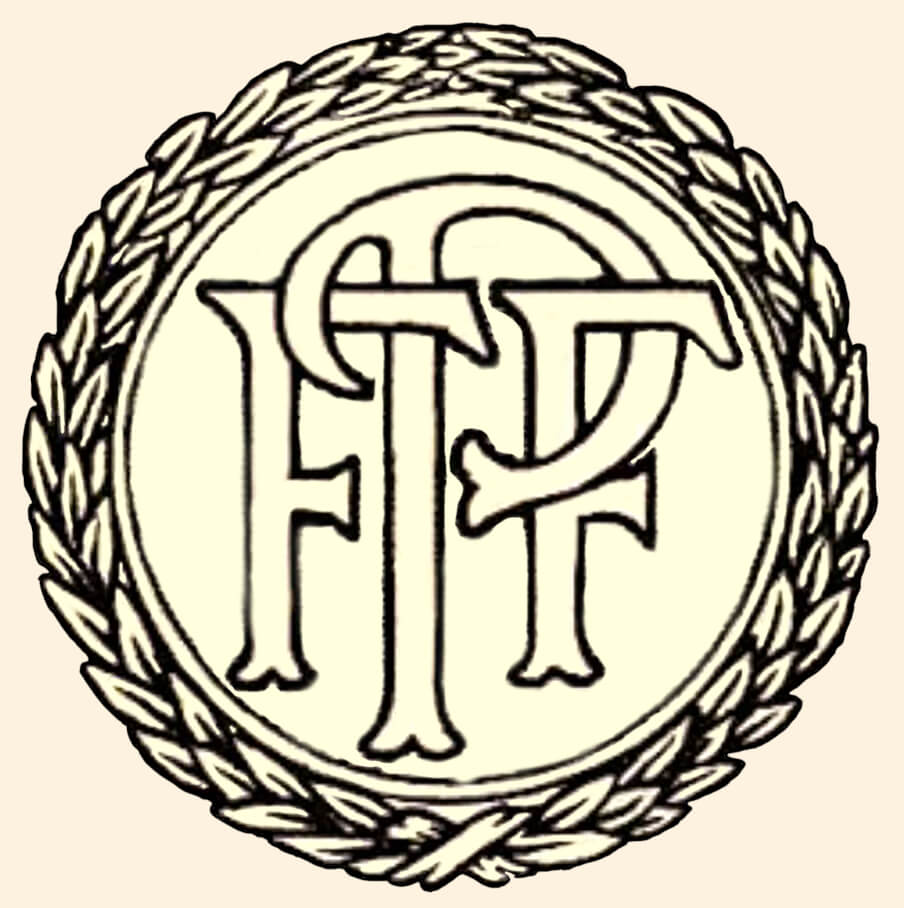
Famous Players
Film Co.
Company active 1912-1916
While Jesse Lasky was developing a successful studio model in Hollywood, another mogul, Adolph Zukor, a Hungarian immigrant, was building his company in parallel. He built studios on both coasts, in New York on 26th St. at 7th Ave. in 1912 and in 1915 he bought a studio at the corner of Melrose and Bronson in Hollywood.
Zukor was the first studio owner to create the formula of buying the rights to popular stage plays and employing already famous stage actors to star in them. His first acquisition was to buy the American rights to the Pathe produced French film Les Amours de la reine Élisabeth (1912) starring famous stage performer Sarah Bernhardt, the most successful actress of the era.
Included among Zukor's stars was stage actress and popular movie actress, Mary Pickford, actor-director Marshall Neilan and directors Allan Dwan and Donald Crisp.
During his tenure as a mogul he was probably the most powerful of all and, perhaps, the most ruthless.
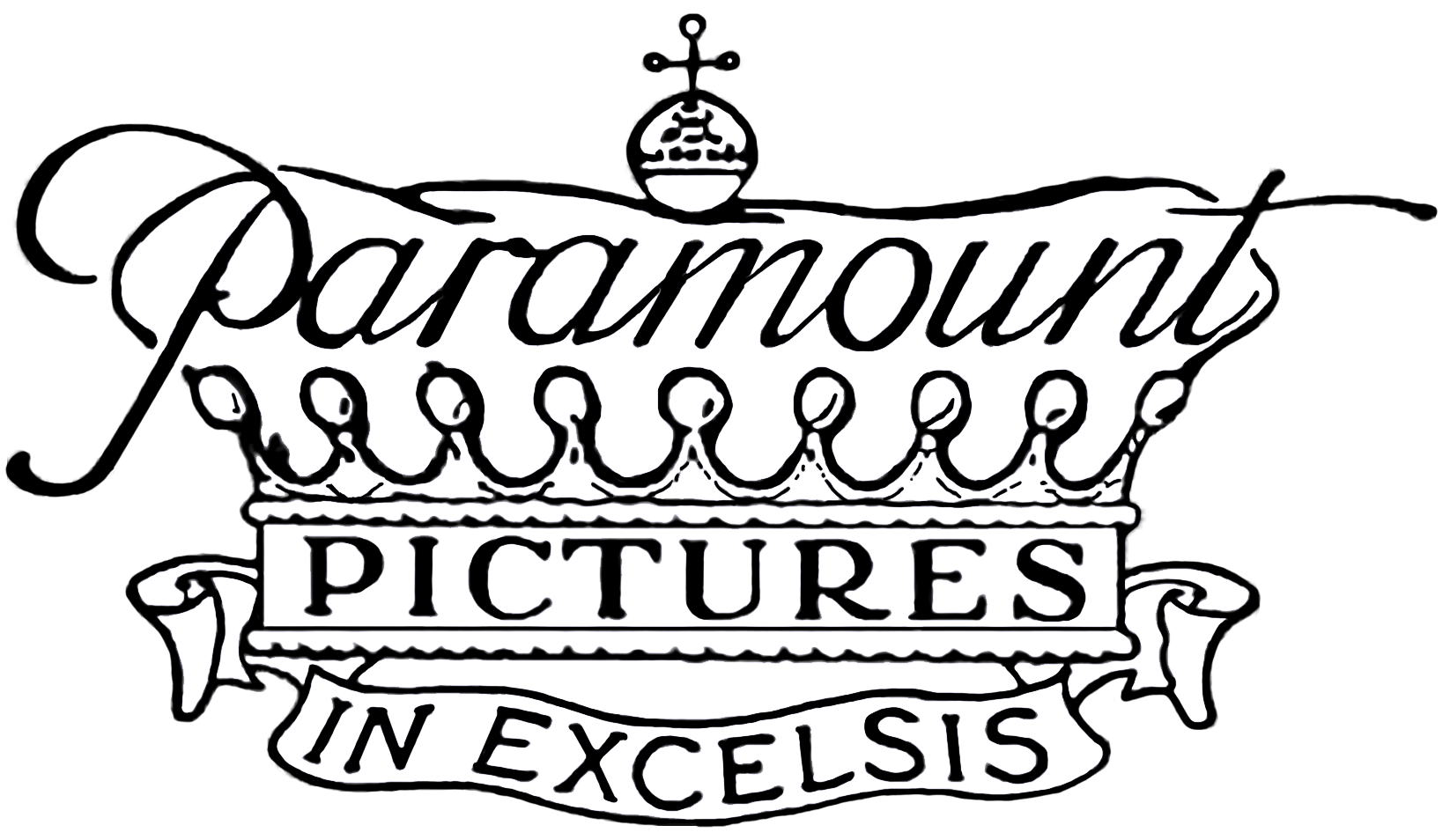
Paramount Pictures
Company active 1914-present
A native of Independence, Kansas, William Wadsworth Hodkinson was born on August 16, 1881. In 1907 the aspiring businessman opened his first nickelodeon in Ogden, Utah and in a few years he bought out his two Ogden competitors and expanded into Salt Lake City.
Needing better control of the products he showed Hodkinson started a new company and joined with the Edison backed General Film Co., becoming a leading West Coast distributor. May 8, 1914 he merged his company with 11 other small exchanges forming Paramount Pictures, the first national, coast-to-coast film distribution company, controlling a very large share of the film distribution business. He created the concept of block booking. If a theater wanted to book a particular movie, they were required to buy a bundle of films from all of production companies feeding associated with Paramount. He was also the first distributor to help finance production to insure a steady supply of movies for distribution. In other words, Hodkinson single-handedly created the modern concept of film distribution.
In 1916 Paramount was bought by the newly formed Famous Players-Lasky Film Company as a subsidary. Its assets were merged into the company and formally absorbed in 1918.
A Big Merger with Huge Ramifications
The studio undergoes big changes, becomes (and still is) the largest in Hollywood proper

6284 Selma Ave. at Vine St. Active at this location 1916-1926
In 1916 the Famous Players and Jesse Lasky companies were both successful, though not much more than other companies of the era. What made them different was their vision and both were well-capitalized.
On June 28 of that year, Adolph Zukor and Jesse L. Lasky agreed to merge their production companies and on July 19 the transaction was finalized. The merged company, with headquarters and a studio in New York, settled in at Laksy's studio at the corner of Selma and Vine Streets bringing most of the company's production to the west coast.
The new company would be called Famous Players-Lasky. Zukor emerged as company President with Lasky as the Vice President, Samuel Goldwyn was named Chairman of the Board, with Cecil B. DeMille remaining as Director-General. Al Kaufman remained in his position as Studio Manager. Soon after Goldwyn resigned from the company, retained his stock, and started his own company eventually becoming Hollywood's most powerful Independent producer, and eventually a partner in United Artists.
Lasky was a genial man, but Zukor was ruthless in the way he managed his business. Adolph Zukor began buying Paramount Pictures stock back in 1915, and a month after the merger of his company with Lasky's, Zukor had accumulated a majority of Paramount's stock. The stock was sold to Famous Players-Lasky and Paramount's assets merged in. Shortly after that Hodkinson was forced out of the company he founded.
This was the beginning of the merged company's move into vertical integration. They bought out and merged in several other production companies and added a theater chain, Katz and Balaban, in the process. They now controlled the entire movie-making process from production to distribution to exhibition. They were the first company in the world to do this, and other companies followed.
Studio Growth
The studio underwent tremendous growth after the merger, expanding to fill two city blocks.
Toward the end of 1916, it appears that Zukor acquired the property that adjoined the original studio, the block to the east of Argyle Street. As near as I can tell right now it was Zukor's separate property, not the company's, while Lasky and DeMille retained ownership of the western half of the property.
The Famous -Players-Lasky Studio (still know by its common name, Lasky Studio) weighed in at 8+ acres.
The company finished filling out the western half of the studio, by 1917 adding stage 4, and open-air stage with the same 60 x 200 dimension as its neighbor. The film lab became part of an expanded Prop Department, and a new lab was built along Argyle Street. An extensive construction department (carpentry, painting, upholstery, etc.) were also built along Argyle. Across Argyle, on the newly acquired vacant lot, they built a backlot with permanent outdoor sets. There were a couple of small villages, a small-town residential street, and a New York-style street.
By 1922 Stage 4 was enclosed as a 5th glass stage, a "dark" stage replaced the scene dock along Selma Ave. Altogether there were now 6 stages. The backlot had completely filled with permanent sets. They added a studio in Fort Lee, New Jersey and kept their studio in Astoria, New York.
Famous Players-Lasky was the most productive company in the industry.
The Future
Eventually, Famous Players-Lasky outgrew their 8 acres and began looking for property where they could expand.
It wouldn't be long before Zukor made Famous Players-Lasky one of the most powerful names in the business. In 1926 they bought out the 18 acre United Studios on Melrose Ave., with plenty of additional land they could lease and buy, to keep expanding the company's holdings. In 1927, to celebrate their new studio, they changed the name to Paramount Famous Lasky Corporation. Circa 1930-1931 they were known as Paramount Publix, Corp., merging the theater chain into the name. In 1933, after filing for bankruptcy, Zukor reorganized and changed the name to Paramount Pictures Corp., the name it has been known by ever since.
Paramount became one of the "Major" studios and is still the largest studio in Hollywood proper.
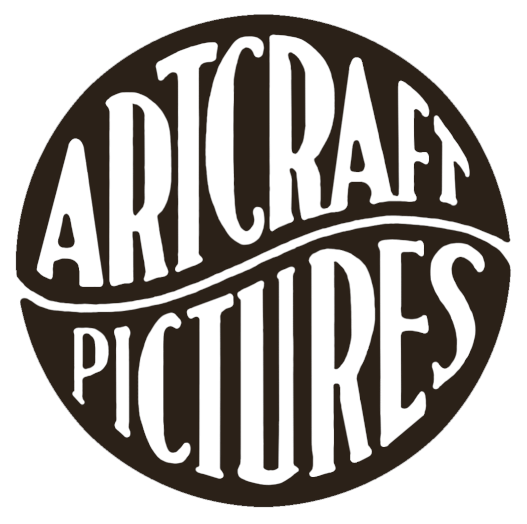
Artcraft Pictures
The "other" brand
For 5 years, Famous Players-Lasky had a "brand" that was a sibling of Paramount for distribution of prestige pictures with prestige stars. It was called Artcraft Pictures and was formed by Walter E. Green in 1916 for "the new class of motion picture theater which demands big features and long runs...for the producer who wants to make masterpieces unrestricted by ...present methods of distribution."
Artcraft's first film was Mary Pickford's "Less than Dust." in 1916.
Founded on August 1 of 1916, Artcraft's original ownership is unclear. On Aug. 1, 1917, its first anniversary, Artcraft came into the hands of Adolph Zukor and Jesse Lasky. More stars were added to the stable: Douglas Fairbanks, William S. Hart, Wallace Reid, Lillian Gish, Dorothy Gish, Mae Murray, Geraldine Farrar, and directors D.W. Griffith, Cecil B. DeMille, and Thomas Ince. The cream of Hollywood. The "Star System" was born.
At its zenith, Artcraft had 16 exchanges throughout the U.S. and Canada feeding hundreds of theaters producing millions in revenue to the studio.
During the 5 year run for the brand, they distributed 62 quality films, most of them produced by parent company, Famous Players-Lasky. By 1919 Artcraft lost three of its biggest stars, Pickford, Fairbanks, and Griffith who formed their own distribution company, United Artists.
In 1921 Zukor folded the brand.
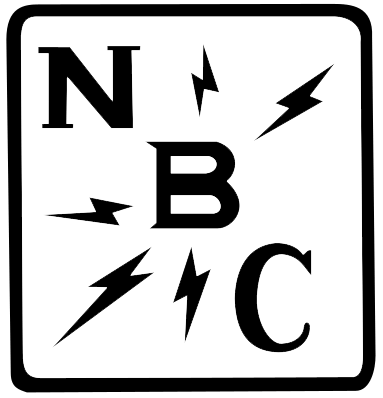
NBC Radio City, Hollywood
NBC Studios
Sunset Blvd. and Vine St.
Active 1938-1964
When radio was king, before television became mainstream, every household had a radio set and families would sit around the set for their nightly entertainment. Radio produced shows very similar to what we now see on TV, but without the picture. Comedies, dramas, talk shows, game shows, musicals...commercials. There were radio stars, just like we have TV stars today. Movie stars would be guests on talk shows and would star in radio plays. Radio was also the domain of the big bands and singers. Families would rush home to listen to their favorite programs. Dinner was often around the radio.
During this radio heyday, all of the major radio networks had a west coast presence in Hollywood. CBS, NBC, and ABC were all located within eyeshot of one another along Sunset Blvd. NBC began its Hollywood life on Melrose sandwiched between RKO and Paramount Studios. In 1938 they built a large, brand new multi-stage West Coast headquarters in response to CBS's new studio. ABC followed a few years later.
NBC's Radio City West sat on the corner of Sunset and Vine, which had been the western half of the old Famous Players-Lasky movie studio, then grew to fill the entire block bound by Selma on the north, Sunset on the south, Vine St. on the west and Argyle Ave. on the east. It was built in the Art Deco style, and was a 3 story building with 8 stages and could seat large audiences.
When television came along, the studios were retrofitted for TV broadcast and many of NBC's life shows originated from Sunset and Vine. "The first television show shot here was "Truth or Consequences" with Ralph Edwards in October of 1950. The show pioneered the three-camera set-up and was shot on film and played from the film to the east coast and three hours later replayed on the west coast. This technique was borrowed by Desi Arnaz for "I Love Lucy" and became the standard way to shoot sitcoms and live TV, eventually transitioning to videotape instead of film.
In 1950 NBC bought a parcel of unused land from Warner Bros. where they built a brand new television facility.
Radio City West was also the base for NBC's Los Angeles television station, KNBH-TV. In 1954 the call letters were changed to KCRA and in 1962 the call letters were changed to KNBC and the company move all production to Burbank.
This studio was torn down in 1964. It has been the site of a bank ever since.
Research and additional photos courtesy of Marc Wanamaker / Bison Archives, and Hollywood Heritage.








